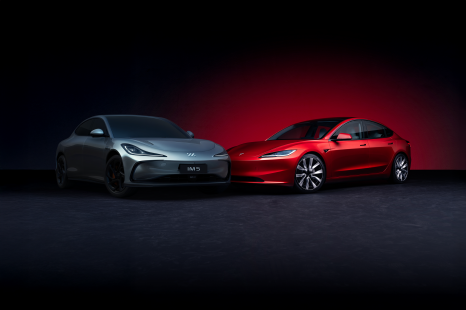

Andrew Maclean
MG IM5 vs Tesla Model 3: Spec battle
39 Minutes Ago
The Ioniq 6 is Hyundai's realisation of its Prophecy Concept. Does this slinky electric four-door have what it takes to beat the Model 3?
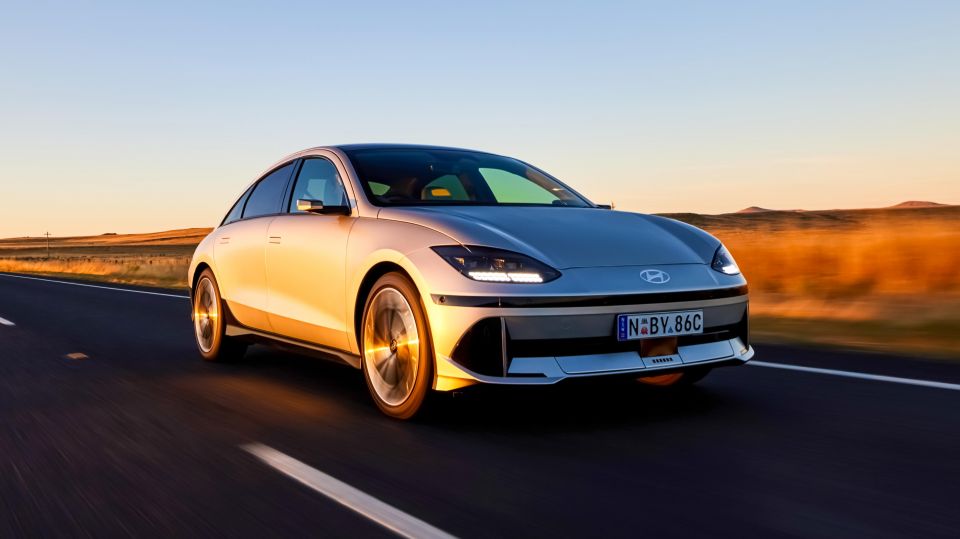


Quickly see how this car stacks up against its competition. Select any benchmark to see more details.
Where expert car reviews meet expert car buying – CarExpert gives you trusted advice, personalised service and real savings on your next new car.
Not often do manufacturers turn good-looking concepts into good-looking production models.
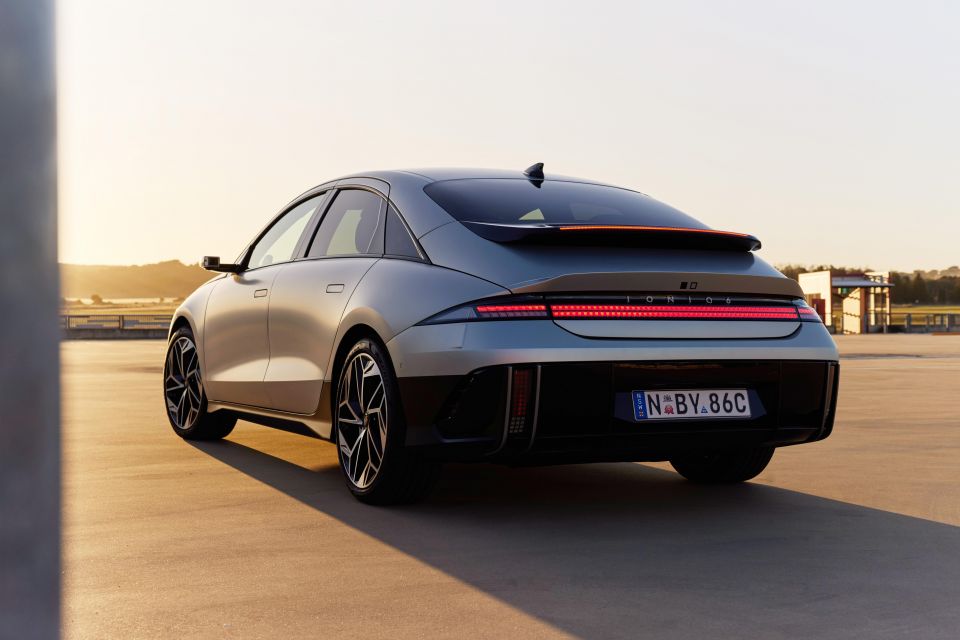
Hyundai did a good job turning its 45 Concept into the Ioniq 5, which wears retro-modern design cues inspired by the Pony of the 1970s.
Then the brand revealed the Prophecy Concept in 2020; a wild two-door electric coupe with a slinky profile in a nod to the streamliners of the 1920s and 1930s.
A couple of years later the Hyundai Ioniq 6 debuted, drawing heavily from the Prophecy’s design but translating it to a four-door sedan body.
It’s the second Hyundai model on the company’s E-GMP dedicated electric car architecture.
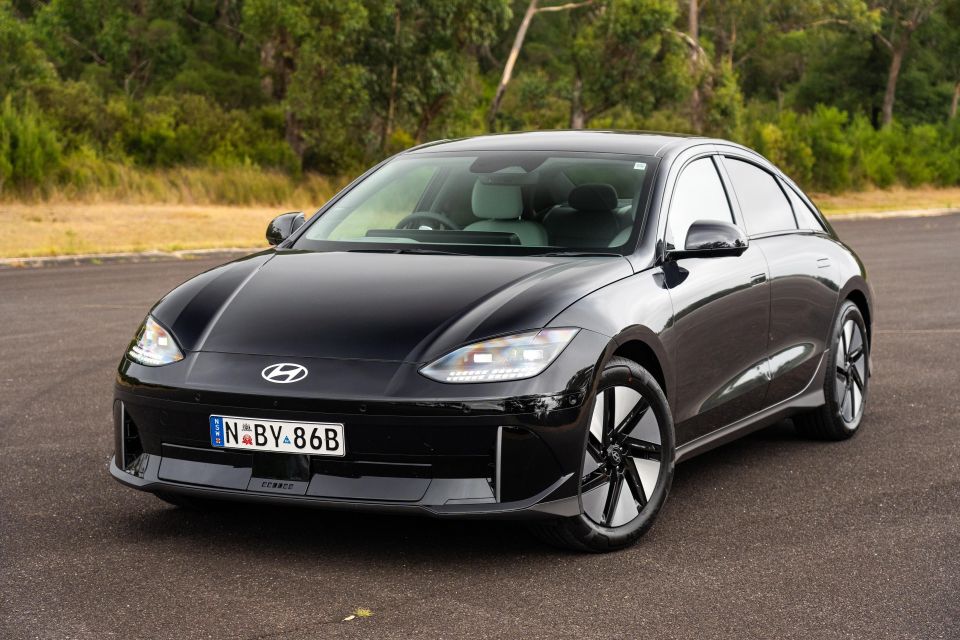
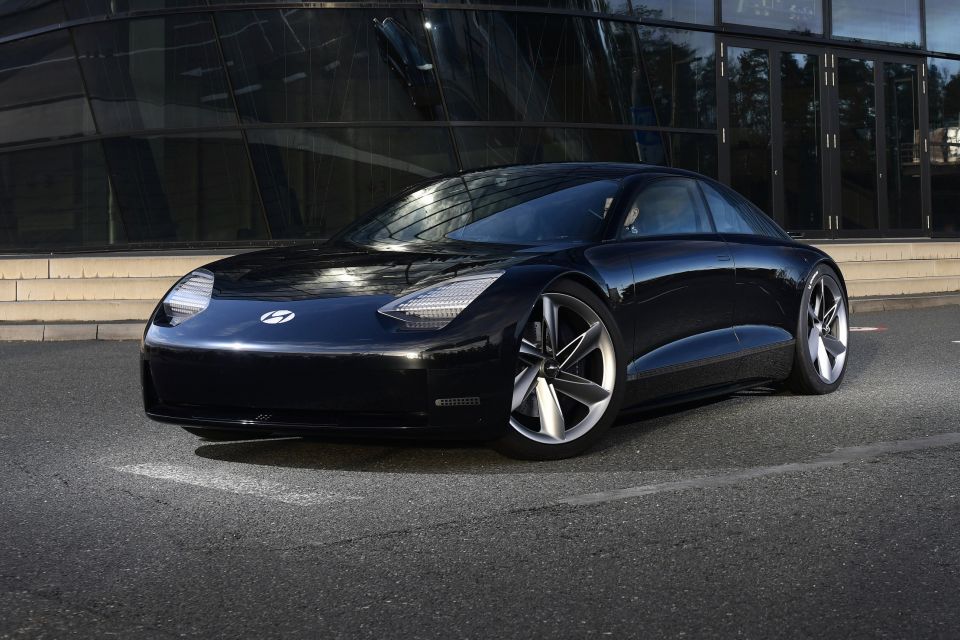

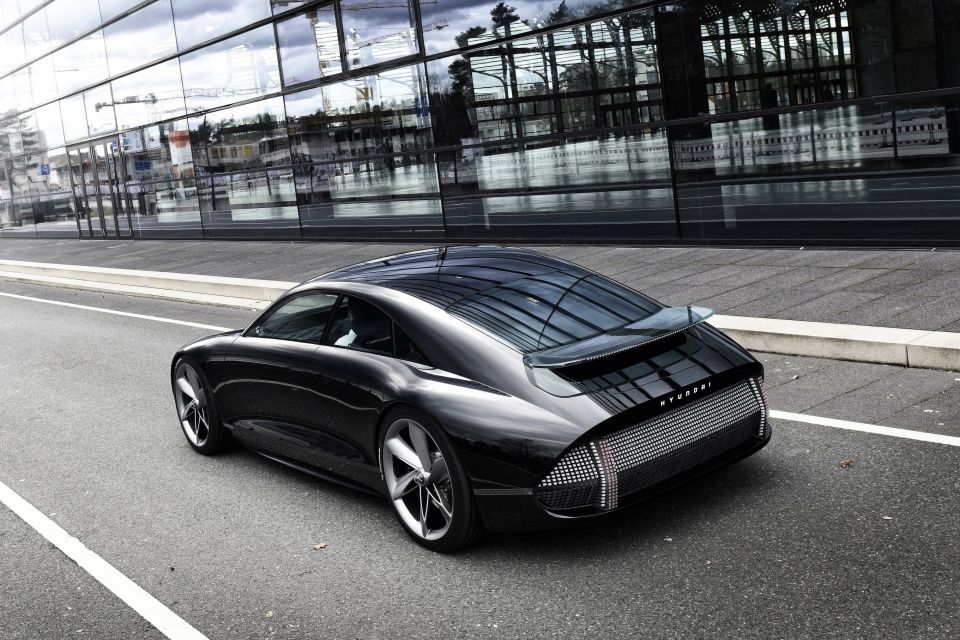
While it’s not quite as true to its concept as the Ioniq 5, so much of the Ioniq 6’s design DNA is clearly drawn from the Prophecy, and it cuts a real line in traffic.
It’s not classically handsome, but I’m a big supporter of brands giving distinctive designs a go and really owning it. Hyundai has form doing that across the board – look at the latest Kona and Sonata designs, for example.
Despite sharing its architecture with the Ioniq 5 as well as the Kia EV6, the Ioniq 6 is distinctly its own vehicle. This is no rebadge.
It’s also the first non-SUV or crossover to be released on the E-GMP architecture, which should lend it a different feel on the road.
Beyond the swoopy exterior and the Parametric Pixel dotted LED lighting all round, Hyundai has put an emphasis on making the Ioniq 6’s cabin a ‘sanctuary’.
During the reveal Hyundai likened the Ioniq 6 to a mobile office; a calm, relaxing space with owners able to utilise aspects like the flat centre console as a desk for a laptop, or the Relaxation Seats that fully recline like an armchair if you need to stretch out and take a breather.
Like the exterior, it has a distinct flavour and personality that’s all its own – more on that later.
So has Hyundai got a new benchmark on its hands? Or, are you better off heading to the Tesla online store?
Pricing for the 2023 Hyundai Ioniq 6 kicks off at $74,000 before on-road costs for the entry-level Dynamiq RWD.
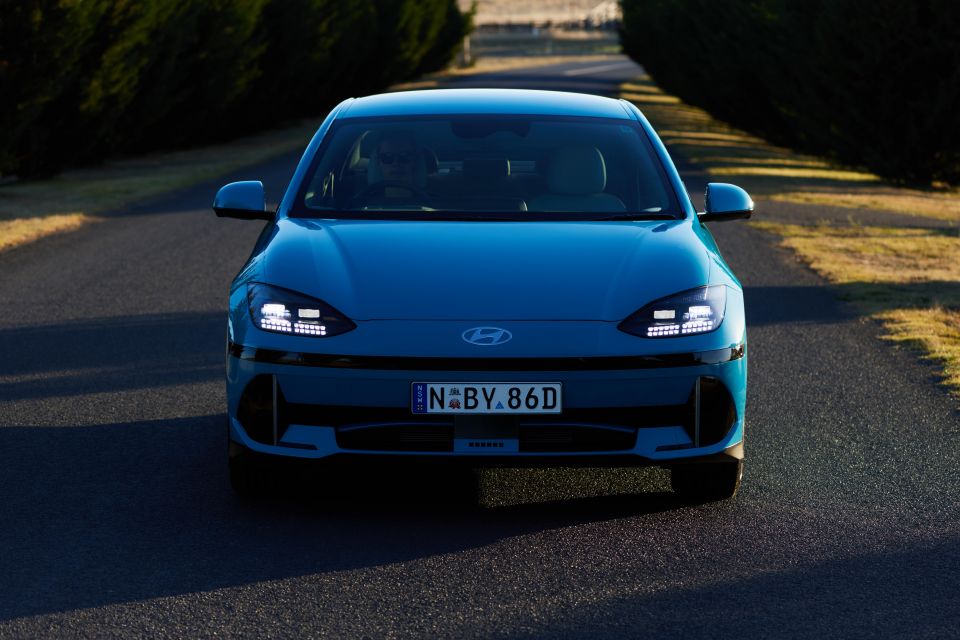
There are three variants in total, with the mid-spec Techniq with dual-motor AWD coming in at $83,500 before on-roads, while the flagship Epiq AWD with its digital side mirrors tops out at $88,000.
Each Ioniq 6 variant carries a $2000-$3000 premium over the Ioniq 5, despite the shared underpinnings and a similar level of standard specification across the board. We’ll dive into the full feature list further down.
The Dynamiq and Techniq both fall under the Luxury Car Tax (LCT) threshold, making them eligible for Fringe Benefits Tax (FBT) exemptions. Further, the base Dynamiq is eligible for stamp duty concessions in NSW, while all models qualify for two years free registration in ACT and Tasmania.
Despite Hyundai identifying the Tesla Model 3 as the Ioniq 6’s most direct competitor, the streamliner is $10,000 dearer than the base of its American-branded rival at the entry-level, though the base model is specified more in line with the dual-motor Model 3 Long Range ($77,300) which is slightly more expensive.
Other logical cross-shops include the Kia EV6 (from $72,590), Polestar 2 (from $63,900) and Tesla Model Y (from $69,300).
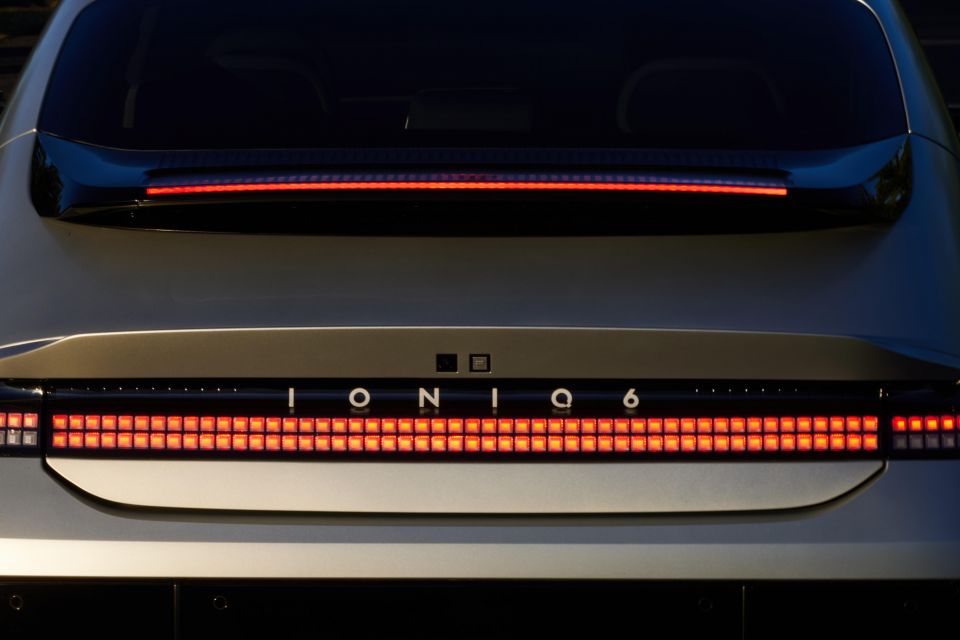
2023 Hyundai Ioniq 6 pricing:
Prices exclude on-road costs
Buy your new car without the stress. It's fast, simple and completely free.

Great service from Travis and team, second time I have used this business would not hesitate to recommend them to anyone
Craig C.
Purchased a Ford Ranger in Sunshine Coast, QLD
CarExpert helped Craig save $7,224 on his Ford Ranger, now let us save you on your next new car.
Get your BEST priceHyundai describes the Ioniq 6’s cockpit as a ‘sanctuary’.
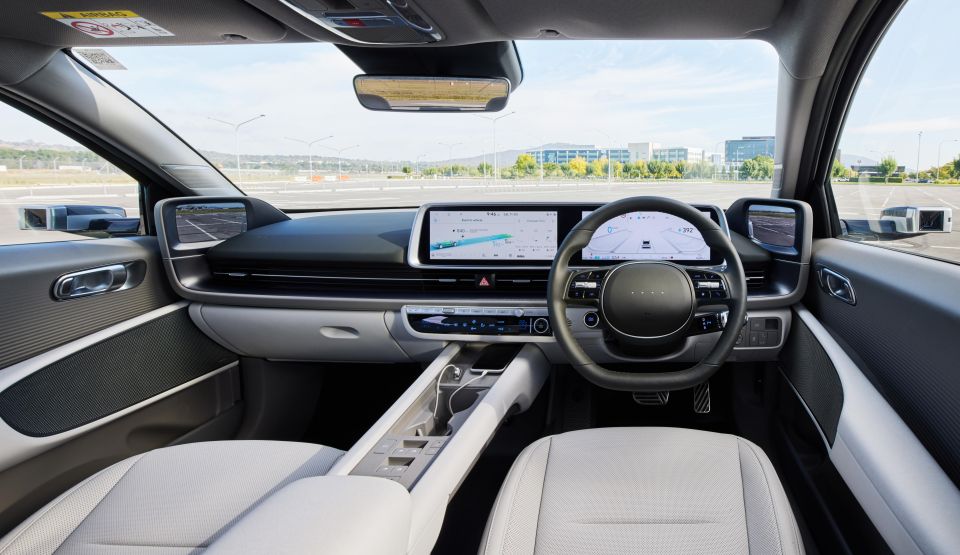
It’s a bit same-same-but-different compared to the Ioniq 5, with a more conventional layout overall but with details that are distinctly Hyundai and Ioniq.
Take the ‘bridge-type centre console’, for example. It houses everything from the window switches to the cupholders and wireless charging pad. It even has a big shelf underneath the top tier for more hideaway storage.
While this is quite different to the 5’s sliding centre console, and the recycled white plastics and grey switchgear make it look like a re-purposed Super Nintendo controller, it follows the open space concept adopted by its stablemates.
I personally really like the setup, once you get used to reaching for the centre console rather than the doors for the window switches. Commodore owners will feel right at home.
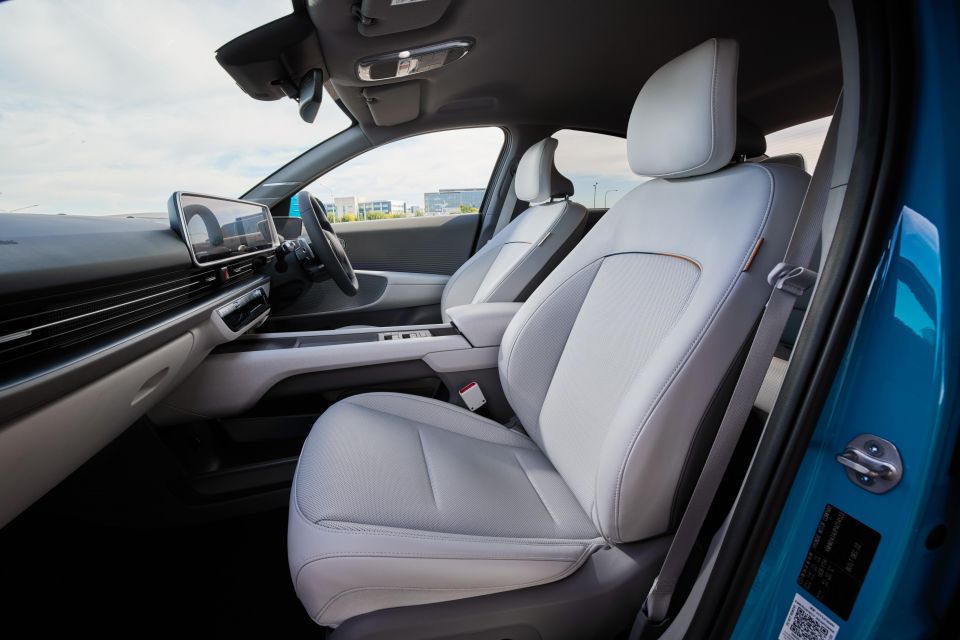
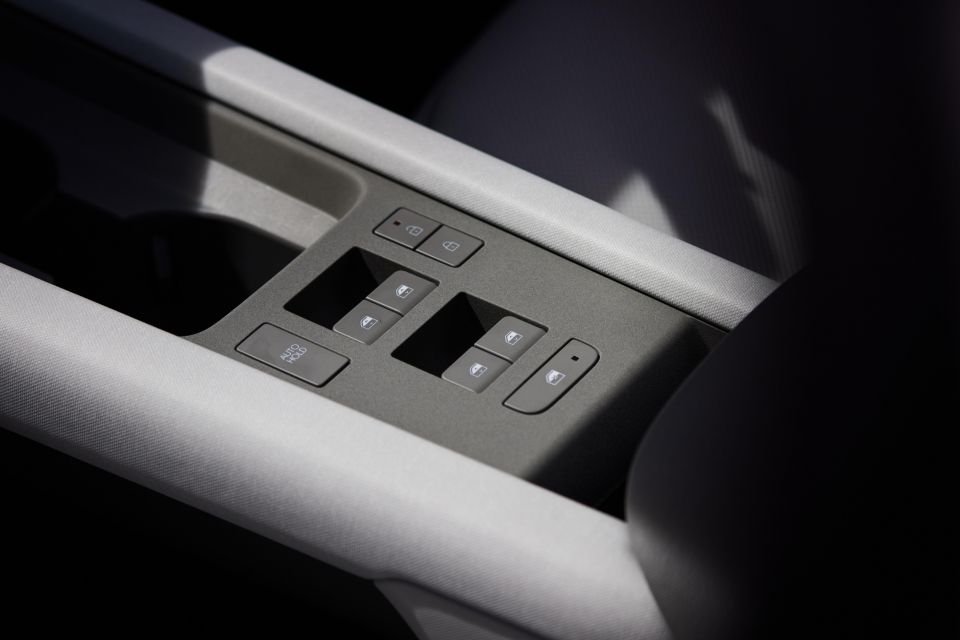
Hyundai says it focused on maximising legroom in the front and rear, as well as slimming the door cards and centre console to add to the feeling of space up front.
You definitely aren’t short for space nor storage up front, though the raised driving position will have taller occupants concerned about their hair touching the headliner.
There’s a pixel-looking design to the Qi wireless charging pad, and the squared-off cupholders have retractable teeth to keep things secure – though small Red Bull cans may rattle around a bit.
It’s fairly conventional ergonomically, save for the column-style gear selector Hyundai is filtering out across its line-up of new vehicles, as well as the touch-capacitive buttons for the climate controls.
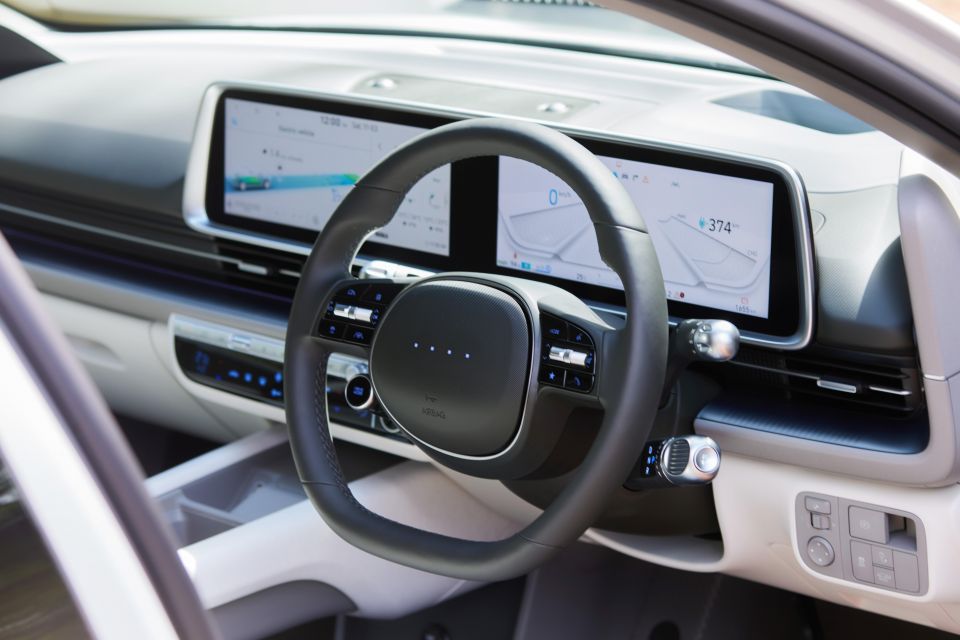
The dual 12.3-inch displays for the instrument cluster and the infotainment are common to other vehicles within the Hyundai and Kia stables, but there’s one main thing that sets the Ioniq 6 apart from most.
Hyundai Bluelink connected services are featured as standard across the range (five-year subscription), which is a key point of difference compared to the Ioniq 5, as well as the Kia EV6 and Genesis GV60 in Australia.
From an infotainment perspective, it means you have online navigation with connected routing and live traffic updates, in addition to an intelligent voice assistant for control of various vehicle and navigation functions.
You also gain mobile app connectivity to view vehicle status and EV management, maintenance notifications, as well as Find My Car and Remote Surround View functions.
The Ioniq 6 also debuts over-the-air (OTA) software updates for Hyundai in Australia, meaning you can update certain vehicle and infotainment software while the vehicle is parked up at home via a network connection.
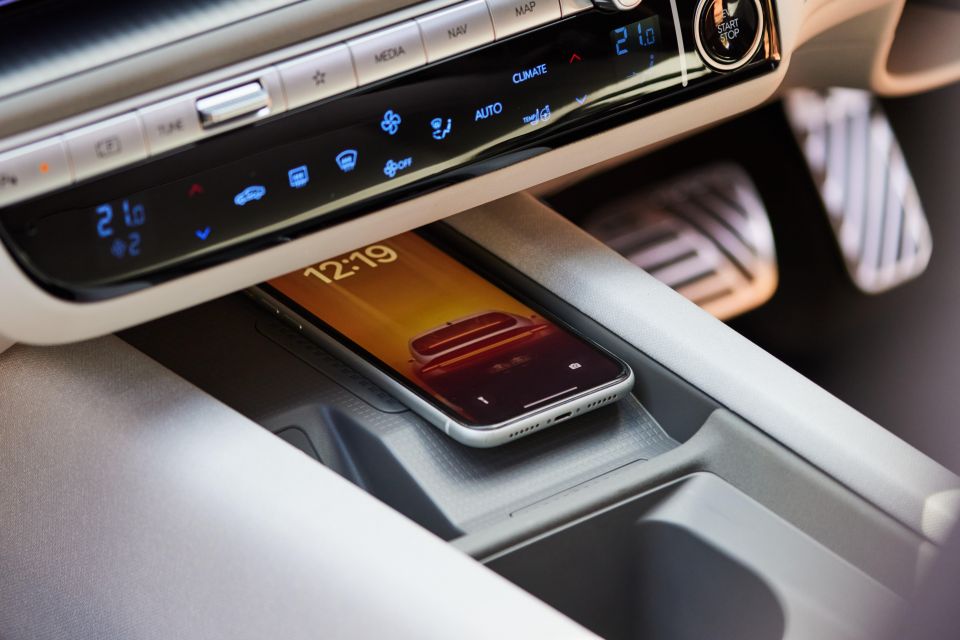
One gripe remains the lack of wireless Apple CarPlay and Android Auto functionality, which seems odd in a vehicle focusing on futuristic design and forward-thinking technology solutions.
Otherwise, it’s pretty standard Hyundai in terms of software. The infotainment is quick to respond to touch inputs and is fairly user-friendly in operation, though given the size of display some form of rotary controller would help to bolster the standard touch functionality.
We used the native navigation system quite a bit during our drive, which seems to offer more accurate travel times and traffic thanks to its online connectivity, and using the embedded system means you get turn-by-turn prompts on your head-up display and within the instrument cluster.
The standard Bose eight-speaker premium audio system is solid without being standout, offering nice and clear sound if lacking a bit of depth compared to some other higher end systems.
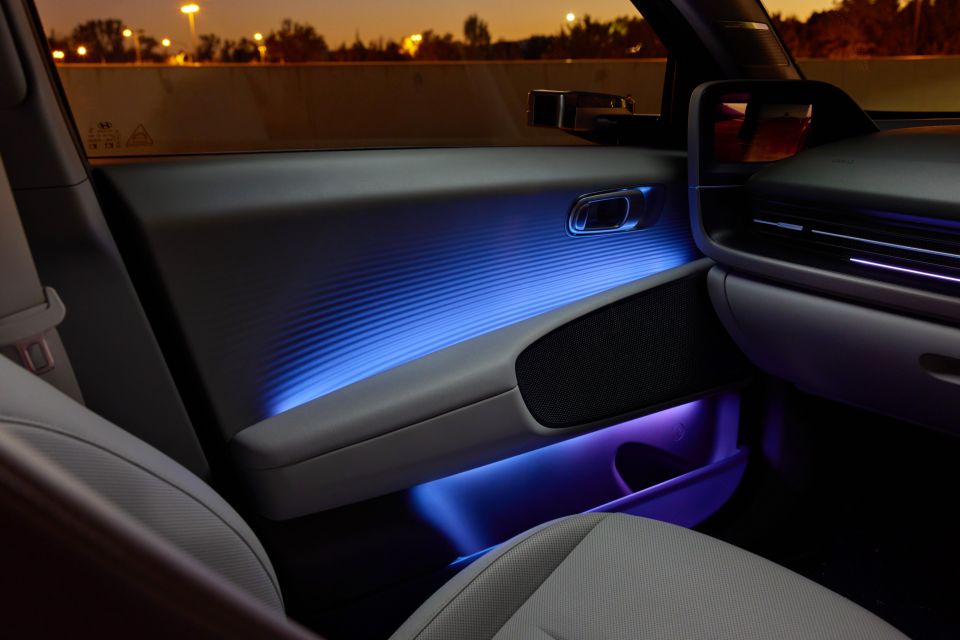
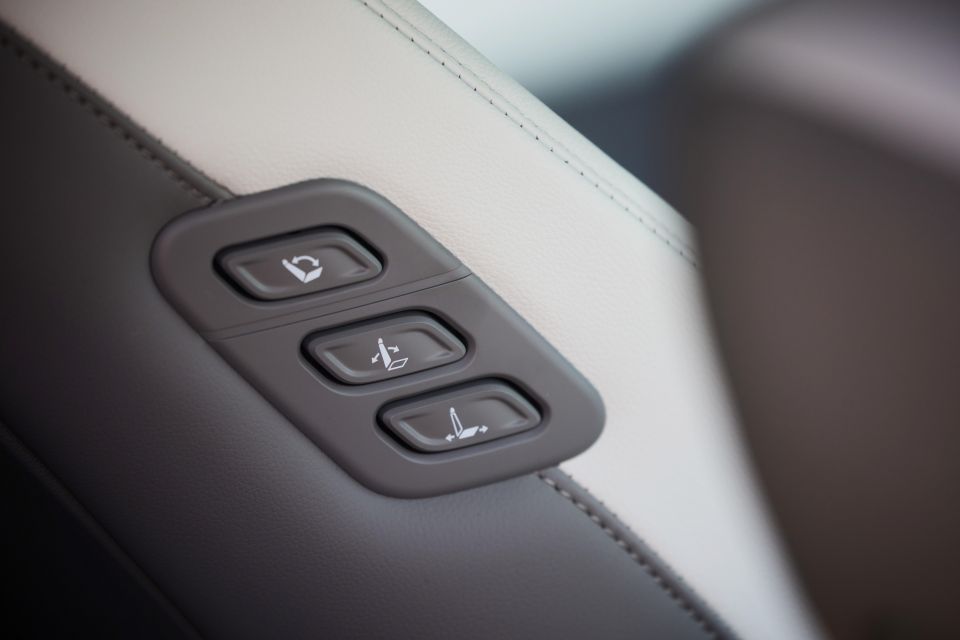
The configurable ambient lighting is pretty cool, and offers pre-configured colour combinations tied to ‘moods’ or ‘themes’, while also allowing you to tailor the space to your liking.
Seat comfort up front is pretty good, even if the pews could use some more side bolstering to hold you in better while cornering on more spirited stints.
Heated front seats come as standard, stepping up to ventilated units up front in the Techniq and Epiq versions – which also sees the outboard second-row seats heated as well as the steering wheel.
The Techniq and Epiq also score the Relaxation function which fully reclines the front seats. This is designed to offer a relaxing place to sit while the vehicle is stopped or charging, but you can also configure this on the passenger seat when the vehicle is in motion.
It’s a cool party trick bolstered by the extra seat controls on the inside of the passenger’s seat, meaning drivers and rear passengers can fiddle with the seat adjustment to allow more space in the back, for example.
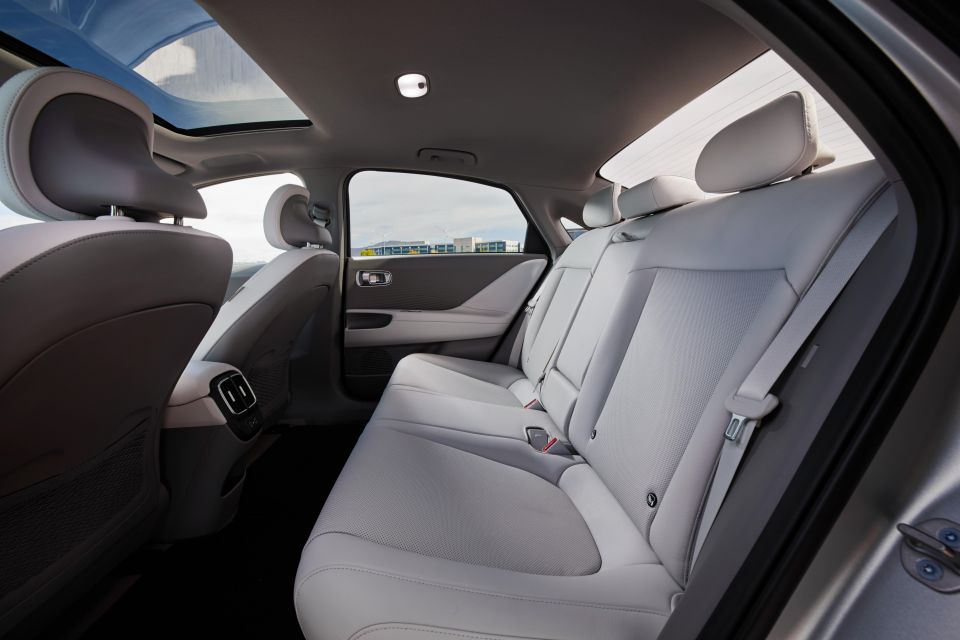
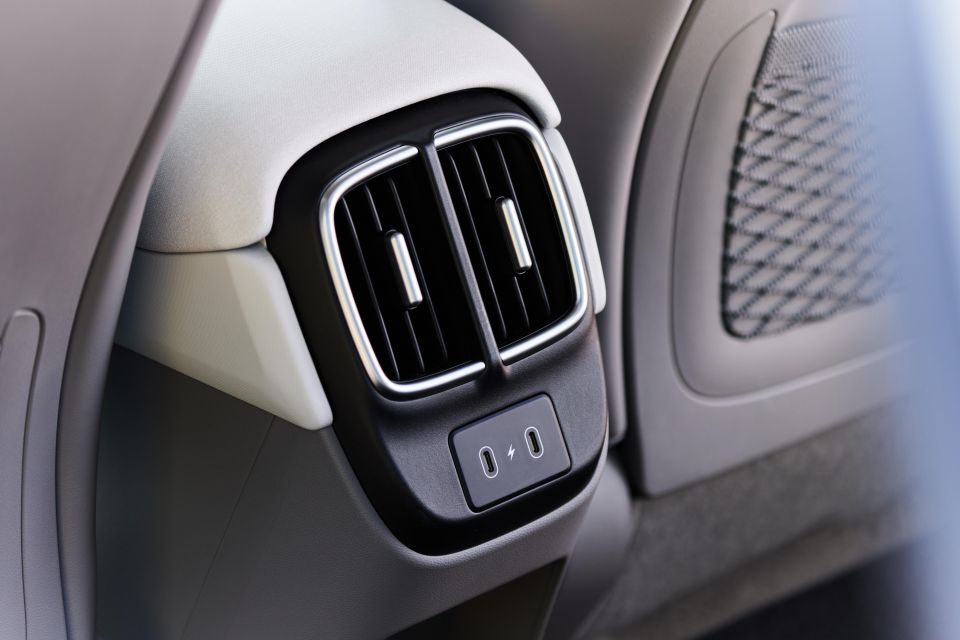
Speaking of the back, the second row of the Ioniq 6 is a decent, but not standout place to spend time.
Leg and knee room are vast thanks to the long 2950mm wheelbase, though the sloping roofline eats into headroom and the high floor means toe room is tight if the front occupants prefer a low seat position.
I’m 6’1 and had more than enough legroom behind my preferred driving position, though I did feel like the headliner was a little close to my head even if I wasn’t making contact.
At least there are directional rear air vents and USB-C charging ports at the rear, as well as netted map pockets and a fold-down centre armrest with cupholders. You also get ISOFIX anchors on the outboard seats, in addition to top-tether points for all three rear positions.
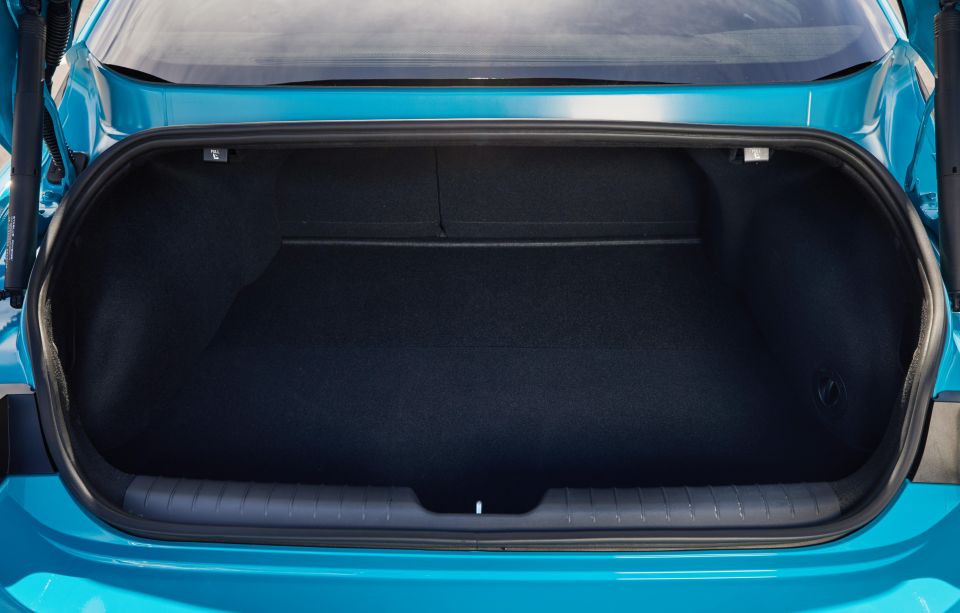
Further back again under the boot lid is a 401-litre boot (VDA) across the range.
The rear seats can be folded via remote releases to allow for longer items to load through, but if outright practicality is your priority the Ioniq 6’s hatch-backed stablemates might be a better fit.
Unfortunately, no Ioniq 6 offers a spare wheel – full-size or space saver. Instead, a tyre mobility kit is standard across the range.
There’s a small cargo area to store things like your portable charging cables, measuring 45 litres in RWD versions and a piddly 14.5 litres for AWD models.
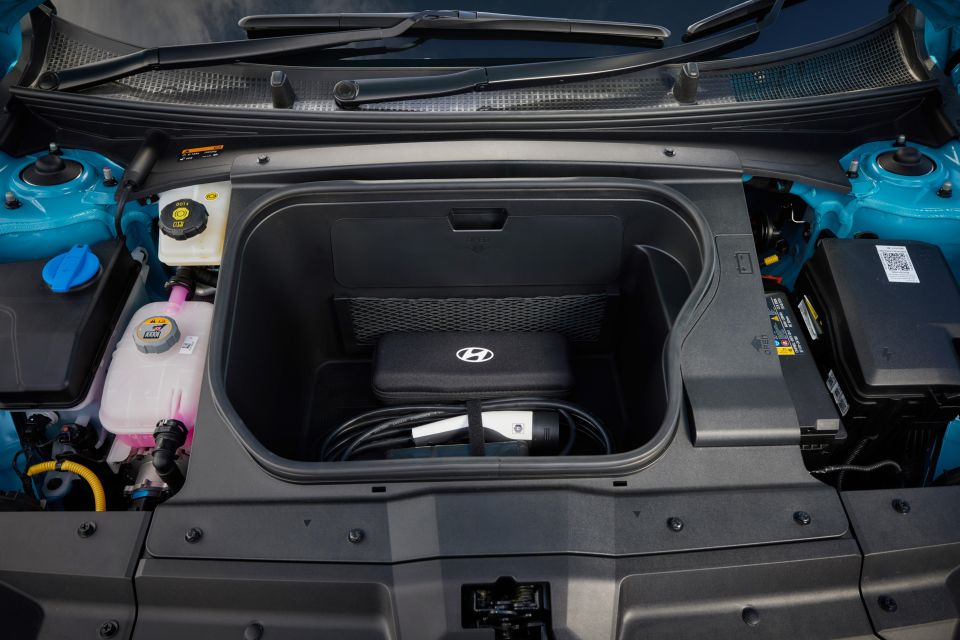
As with the related Ioniq 5 and Kia EV6, there are two drivetrains on offer.
Dynamiq variants are powered by a 168kW/350Nm electric motor on the rear axle. Meanwhile, the Dynamiq and Epiq get a second 74kW/255Nm electric motor on the front axle, for system outputs of 239kW and 605Nm. These models feature electrified all-wheel drive.
Regardless of drivetrain, all versions of the Ioniq 6 in Australia feature the Long Range 77.4kWh lithium-ion battery pack. In other markets, there’s also a Standard Range battery option with 53kWh capacity.
The Ioniq 6 Dynamiq has an impressive 614km of range on the WLTP test cycle, based on an energy consumption figure of 14.3kWh per 100km. Dual-motor versions will do 519km (WLTP), with a consumption claim of 16.9kWh per 100km.
Hyundai claims the single-motor Ioniq 6 can dash from 0-100km/h in 7.4 seconds, with dual-motor variants trimming that to just 5.1 seconds. The brand says the Ioniq 6 RWD can accelerate from 80-120km/h in 4.6 seconds, with AWD models quoting 3.3 seconds.
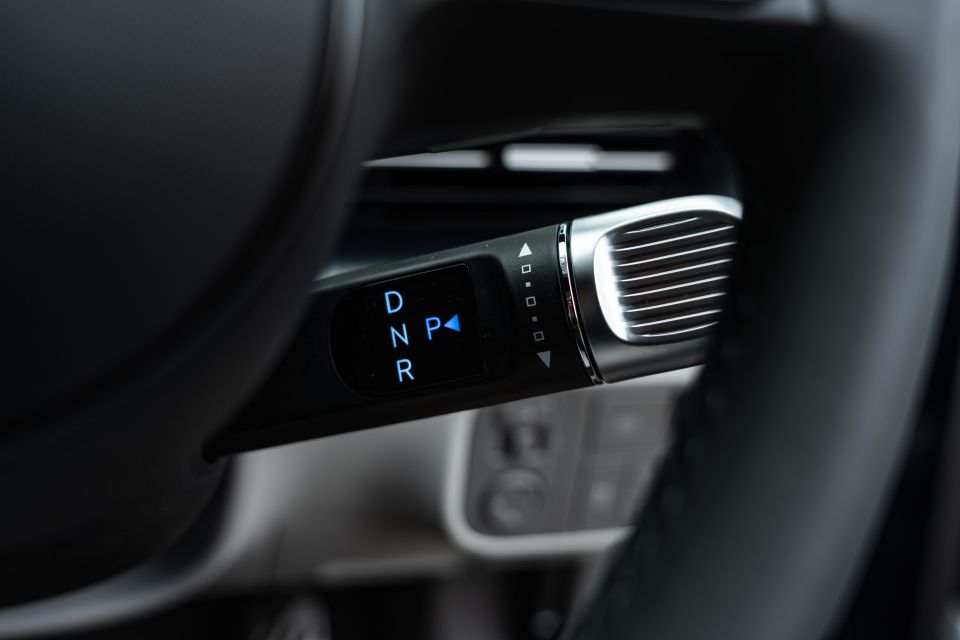
Where expert car reviews meet expert car buying – CarExpert gives you trusted advice, personalised service and real savings on your next new car.
Like the Ioniq 5 and EV6, the Ioniq 6’s battery uses an 800V electrical architecture that supports ultra-fast DC charging at up to 350kW – which would see the battery charged from 10 to 80 per cent in as little as 18 minutes.
Using a more common 50kW DC fast charger would see that 10-80 per cent charge time take 73 minutes. Hyundai also quotes a time for using the ‘Portable Emergency Charging Cable’ via a conventional three-pin domestic socket of 34 hours and 20 minutes.
The Ioniq 6 quotes a braked towing capacity of 1500kg, with a tow ball download limit of 100kg.
While the Ioniq 6 shares its underpinnings with the Ioniq 5 and Kia EV6, it feels quite different to both on road.
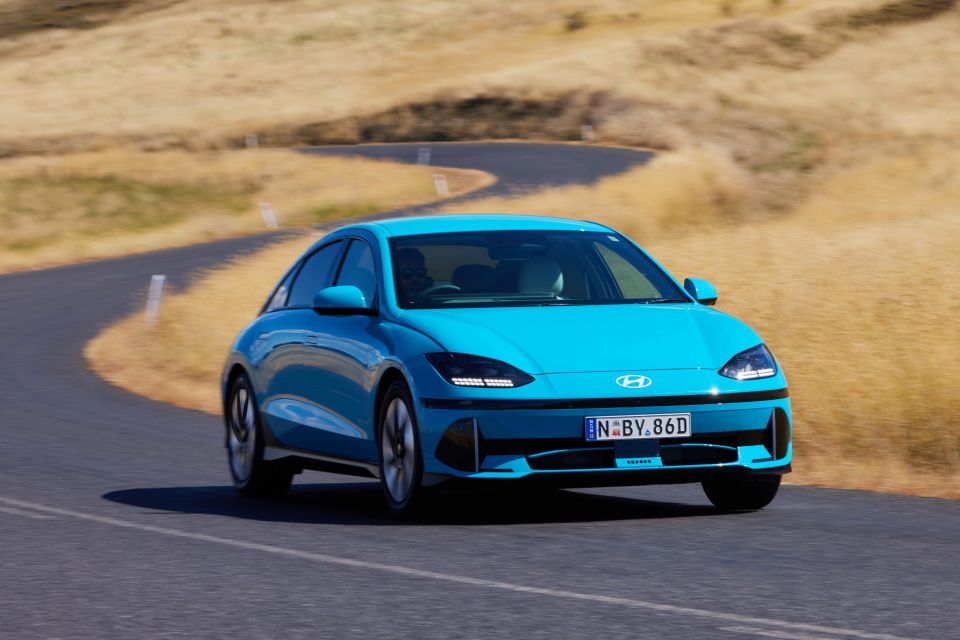
Compared to its crossover-styled siblings, the Ioniq 6 very quickly feels very car-like. Fitting, given this is the first lower-riding passenger car to sit on the E-GMP platform.
Our route for the media launch took us through the sweeping, high-speed roads surrounding Albury and the Murray River on the NSW-VIC border, allowing us to really get a feel for the Ioniq 6’s dynamics (not dynamiqs…)
We spent most of our time in the mid-spec Techniq, which features dual-motor all-wheel drive and 20-inch alloys shod in low-profile 245/40 Pirelli P Zero tyres, and for these sections of road it really gave off a GT sports sedan vibe.
The ride is very tied down and errs on the side of firm, but the fixed-rate adaptive damping isolates the cabin and its occupants very well from road surface imperfections.
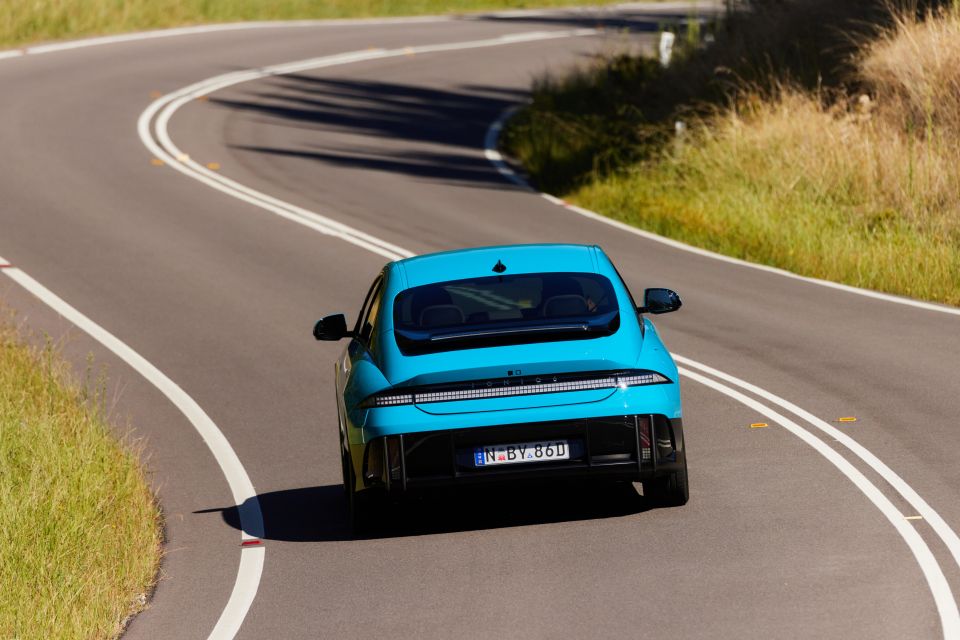
It can feel a touch busy over lower impact, high-frequency bumps and corrugations, but it’s never harsh or crashy as the wheel and tyre package would have you believe.
The steering is accurate and fluid, with a touch of vagueness about centre. It strikes a balance between engagement and usability, because it feels lighter at lower speeds in car parks and around town – making this 4855mm long and 1880mm wide streamliner feel very manoeuvrable indeed.
It’s quick, but in a smooth and effortless way. Dual-motor versions claim a 5.1-second dash to 100km/h which is within striking distance of something like a Mercedes-AMG C43 or Audi S4, and while it feels like it can match its acceleration claim there’s a linearity and smoothness to how it delivers its power that makes it feel slower than it actually is.
The Ioniq 6 is a marked improvement dynamically over the Ioniq 5, which is softer and more comfort-focused, and definitely wouldn’t have felt as adept through the kinds of roads and corners we traversed on the media launch.
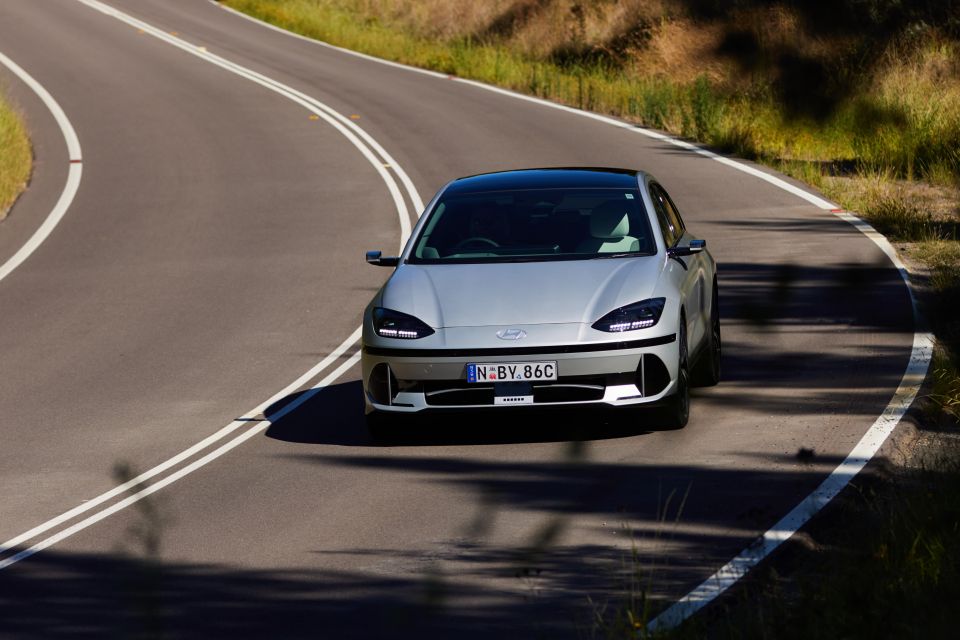
As we hit tighter, more technical sections of road around Lake Hume, again the Ioniq 6 demonstrated its superior handling and dynamics compared to its Ioniq 5 sibling.
Body roll is progressive and well controlled, and there’s heaps of grip which gives you the confidence to push on if you’re feeling a little spirited. Morning rain had left sections with lightly drizzled patches of asphalt, but the Ioniq 6 never felt unsettled or out of its depth.
There’s a real feeling that this car has quite a large footprint, which it does. For the folks at home, the front and rear tracks measure 1635mm and 1644mm respectively, while the wheelbase stretches 2950mm. If this is the standard car, I’m keen to see what they do with an Ioniq 6 N – see RN22e concept.
This is further reiterated when travelling 110km/h on country highways, where the road-hugging stance, low centre of gravity (including clearance of 144mm), and slippery 0.217cd body (Dynamiq) make for a very stable and quiet touring experience.
Road and wind noise is impressively hushed in the cabin, arguably more so than a lot of premium vehicles these days. The Ioniq 6 also wasn’t fazed by some heavy rain I encountered when driving back to Melbourne on the Hume Hwy.
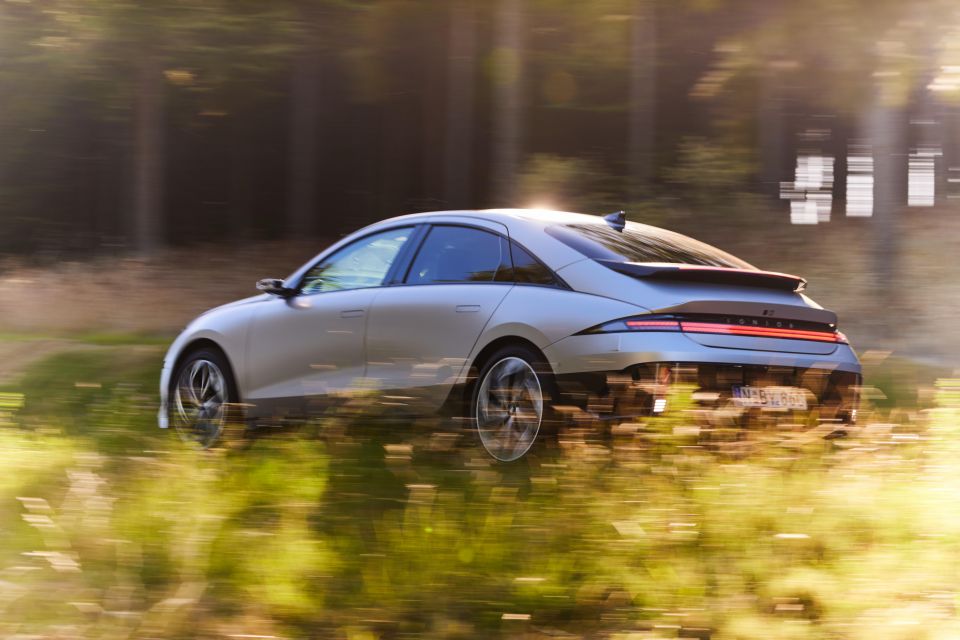
What about the standard RWD? I took a shorter stint in the entry-level Dynamiq around Yackandandah to get a feel for any differences between the single-motor and dual-motor models. To be honest, it really wasn’t that different, at least in the dry.
There’s a little less punch in a straight line, but it’s still more than torquey enough and feels more muscular than its 7.4-second dash to triple figures might suggest. As with most non-performance EVs, its best work is between 0 and 60km/h or 80km/h.
It perhaps feels a little lighter at the front end thanks to it missing a motor on the front axle, and that feeling of being pushed from the rear will appeal to those with more traditional tastes.
Ride comfort and refinement are improved marginally over AWD versions thanks to the smaller 18-inch aero alloys and chubbier 225/55 Nexen eco tyres. It’s that touch softer in the ride and quieter in the cabin that gives it a more luxurious ambience on the move.
Even better, the Dynamiq RWD quotes by far the best driving range in the line-up at 614km, which is nothing to sneeze at – it’s easily one of the best in market for the money, and the efficiency figure feels achievable.

As for assistance systems, the Ioniq 6 offers semi-autonomous highway driving, plus a wide array of active safety features as you’d expect.
Adaptive cruise control and Lane Following Assist combine to keep a safe distance from a leading vehicle, while also keeping you centred in your lane. This came in handy on my 3.5-hour trip from Albury to Melbourne.
Unfortunately Australia doesn’t get a dedicated Highway Driving Assist mode like in other markets, though the aforementioned features effectively perform the same function.
Beyond the semi-autonomous assists, there’s the techy Blind Spot View Monitor standard across the range, supplementing the conventional blind-spot assist feature by projecting a live camera feed of the vehicle’s rearward side view when you indicate.
Matrix LED headlights are also standard across the range, with an adaptive high-beam function that does a great job of lighting up the road ahead without dazzling oncoming motorists. I spent some time on country highways on the way home after dark and while it doesn’t do some of the flashy animations German equivalents can, it does the job.
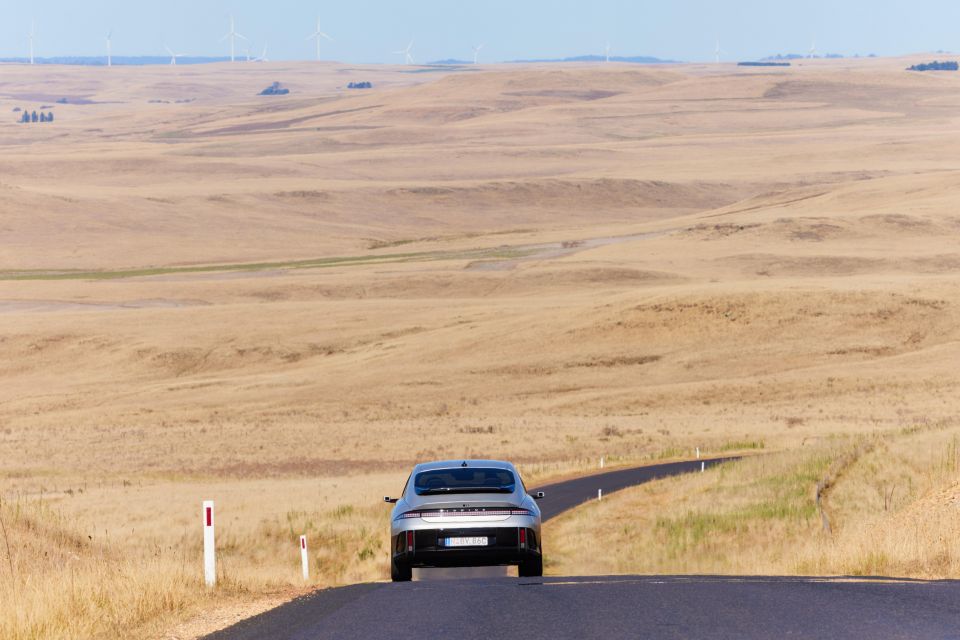
While the bulk of Hyundai’s SmartSense features work well, the constant binging and bonging of the Intelligent Speed Limit Assist would drive me to murder.
There’s a chime when there’s a new speed limit detected – including school zones out of normal school times – and then the vehicle will proceed to beep at you three or so times one the indicated speed exceeds 3km/h of the signed speed limit.
It does this again, and again… and again. Worse still, when you’re on the freeway with adaptive cruise set to a speed 3-5km/h over, the system will repeat this process every time the vehicle slows down and speeds up again.
You can turn this feature off in the driver assistance settings menu in the central touchscreen, but you also have to turn it off every time you start the car.
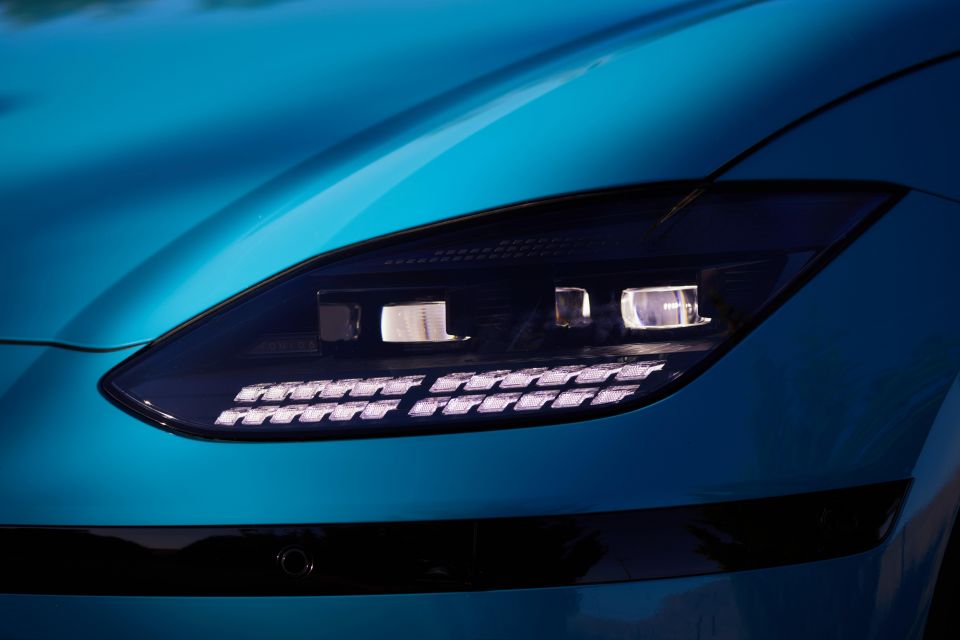

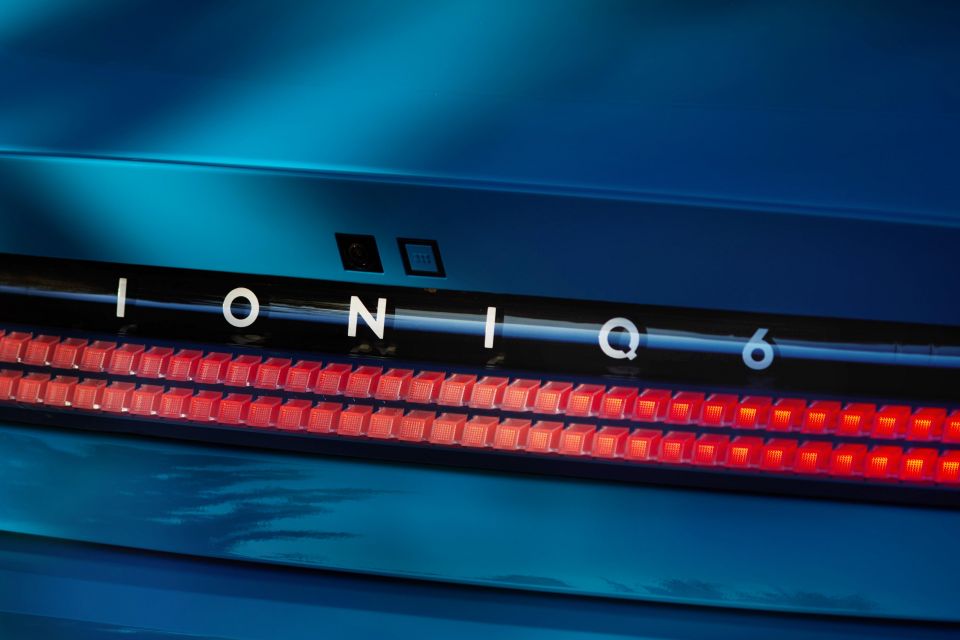

Ioniq 6 Dynamiq highlights:
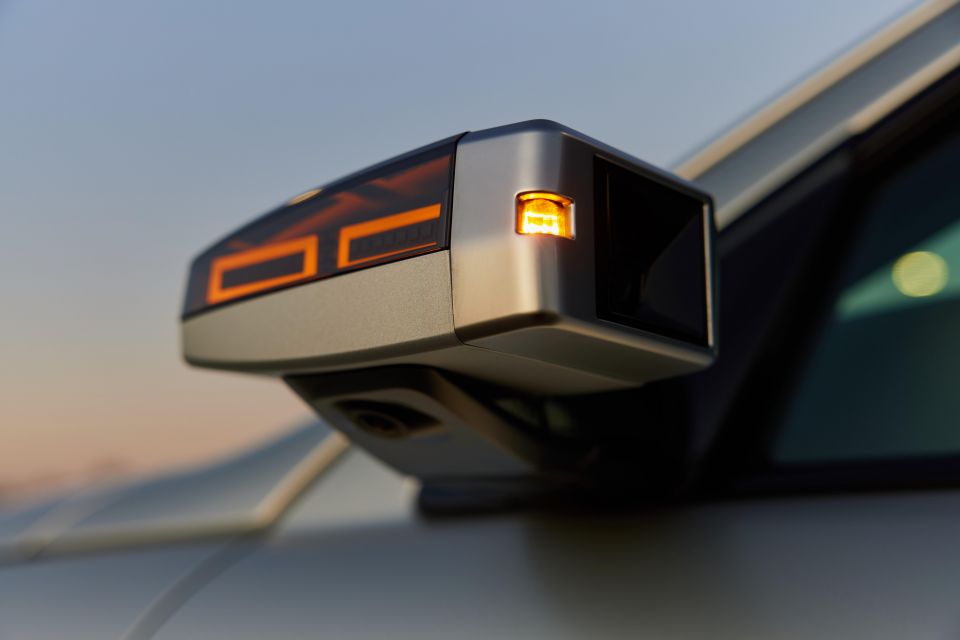
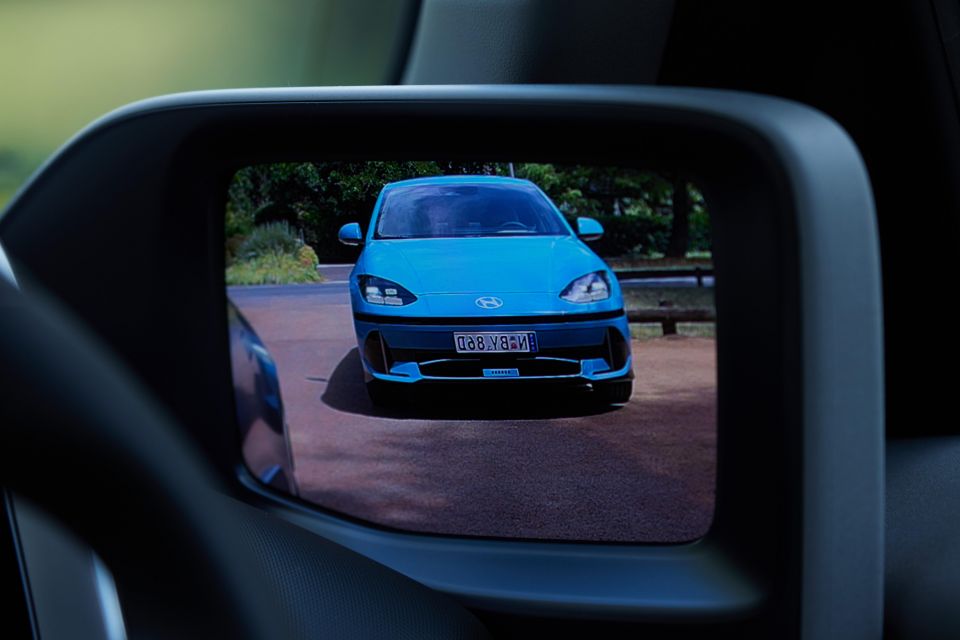
Ioniq 6 Techniq adds:
Ioniq 6 Epiq adds:
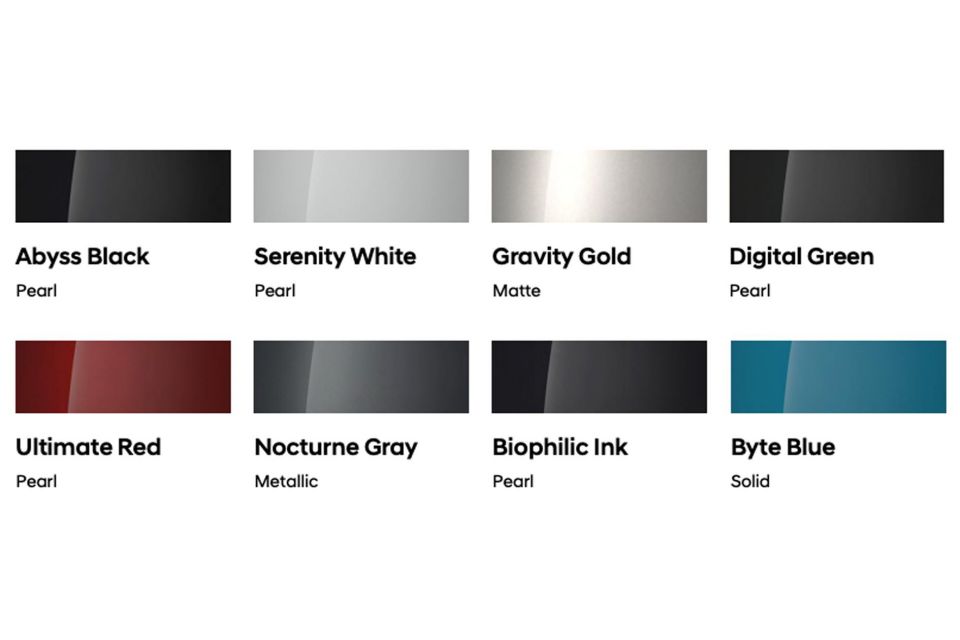
Standard
Optional ($1000)
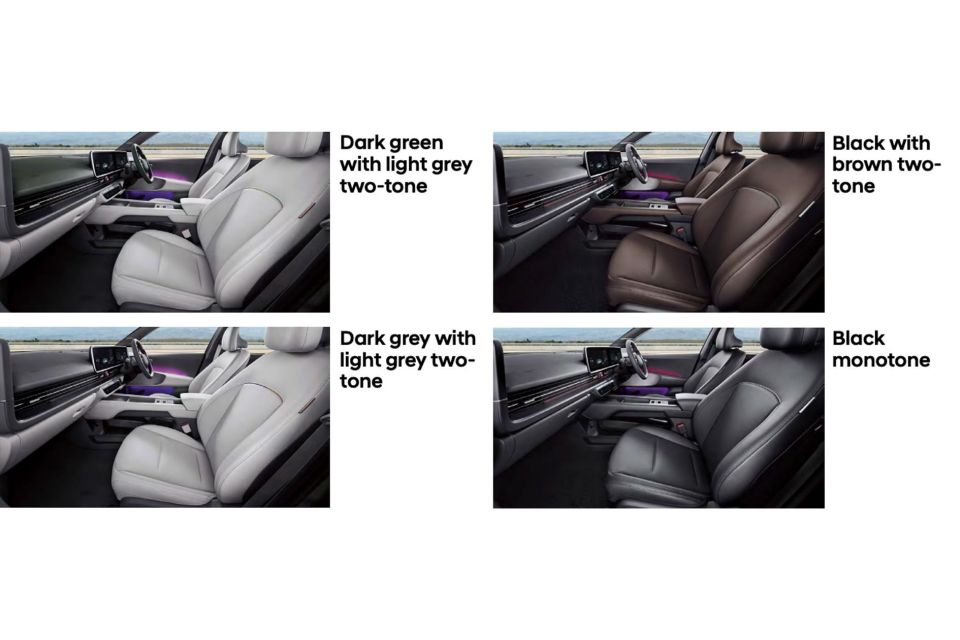
Interior
The Ioniq 6 arrives in Australia with a five-star ANCAP safety rating, based on testing by Euro NCAP in 2022.
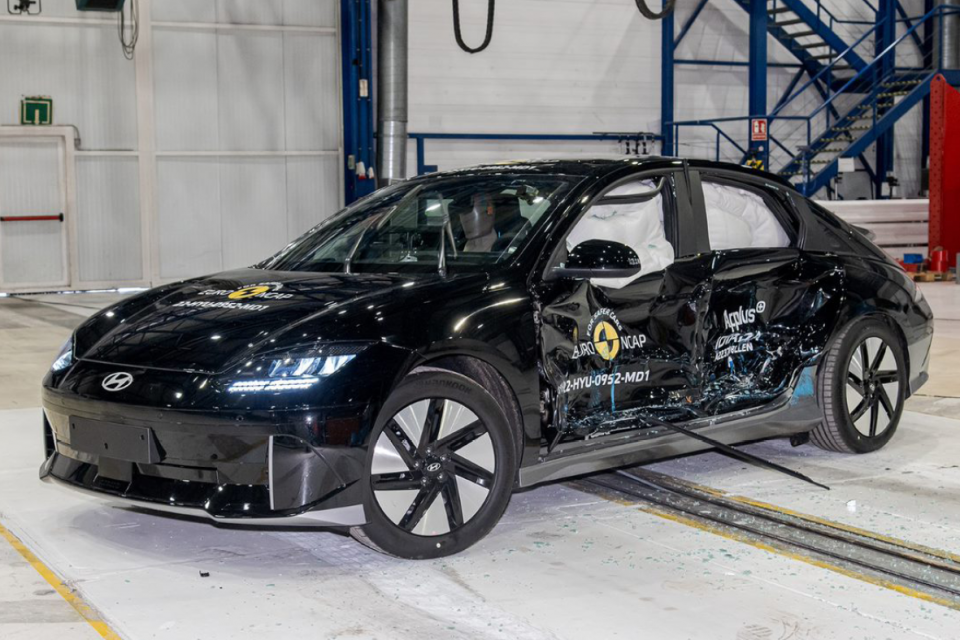
Hyundai’s electric sedan scored an impressive 97 per cent for adult occupant protection, 88 per cent for child occupant protection, 66 per cent for vulnerable road user protection, and 90 per cent for safety assist.
The adult occupant score ties the Ioniq 6 with the Tesla Model Y as the highest-scoring vehicle in that area of assessment for the current criteria period.
“As electric vehicles don’t have large engine components under the bonnet, they have the potential to pose less risk to vehicle occupants in a frontal crash scenario, compared to petrol and diesel cars,” said ANCAP chief executive, Carla Hoorweg.
“We have seen that play out in testing of the Ioniq 6 – with only a very slight penalty applied for potential injury risk to adult occupants.”

Standard safety features include:
As with the wider Hyundai range, the Ioniq 6 is covered by a five-year, unlimited-kilometre warranty.
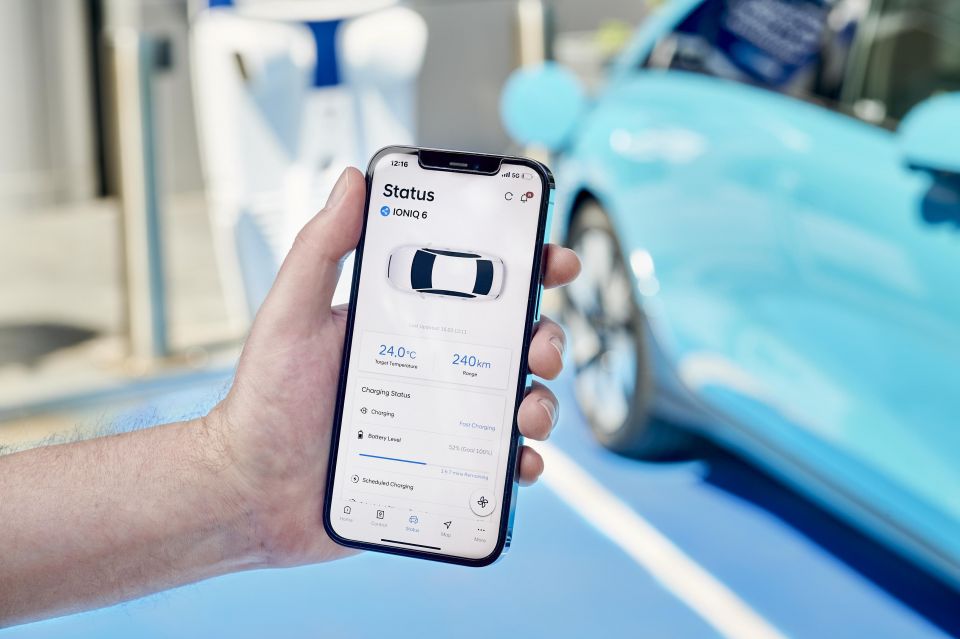
Hyundai covers the high-voltage battery for up to eight years or 160,000 kilometres – whichever comes first.
The Ioniq 6 also gets a complementary five-year subscription to Hyundai Bluelink connected and remote services, and it’s the first Hyundai to offer over-the-air (OTA) software updates in Australia.
Owners get 12 months of 24/7 premium roadside assistance with purchase, which is renewable for a further 12 months every time you service the vehicle at a participating Hyundai dealer. This is available for the lifetime of the vehicle.
Factory satellite navigation mapping can be updated for up to 10 years as part of the Hyundai iCare owner program.
Scheduled maintenance is required every 24 months or 30,000km – whichever comes first. The first two services are capped at $560 each for all variants.
It’s a shame, however, Hyundai doesn’t offer any subscriptions to public charger networks nor any deals on home charger installation like luxury arm Genesis, given the asking price.
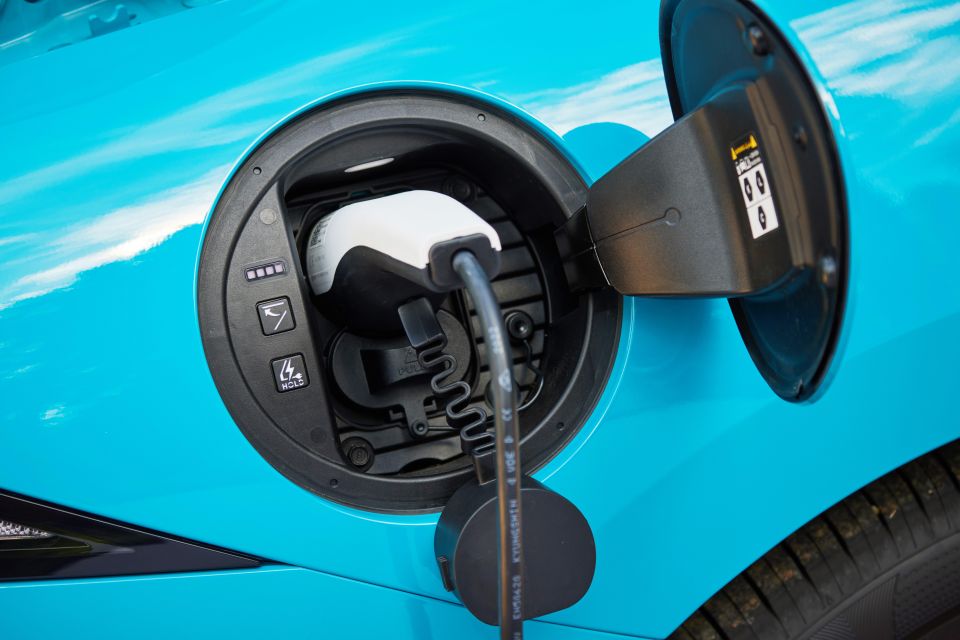
Speaking of battery and charging, we made a pitstop at the Euroa ultra-fast DC charger on the way home from Albury. The Ioniq 6 was pulling around 104kW for the bulk of its charge period, which saw 55.36kW replenished in 33 minutes, costing $33.22.
As for real-world energy consumption, the Ioniq 6 AWD was showing between 19-20kWh/100km for the bulk of our high-speed 100-110km/h dynamic drive, but dropped into the 18-19s once we hit the freeway. It was significantly more efficient once the freeway speed dropped to 100km/h closer to Melbourne.
Following the launch, I drove the Ioniq 6 to and from work from my home in the eastern suburbs of Melbourne to our Docklands office, yielding high 14s to low 15s (indicated) over 20-ish kilometres including some 18km of freeway.
Buy your new car without the stress. It's fast, simple and completely free.

Great service from Travis and team, second time I have used this business would not hesitate to recommend them to anyone
Craig C.
Purchased a Ford Ranger in Sunshine Coast, QLD
CarExpert helped Craig save $7,224 on his Ford Ranger, now let us save you on your next new car.
Get your BEST priceAll told the Ioniq 6 feels like a very complete package, and a worthy alternative to the top-selling Model 3.
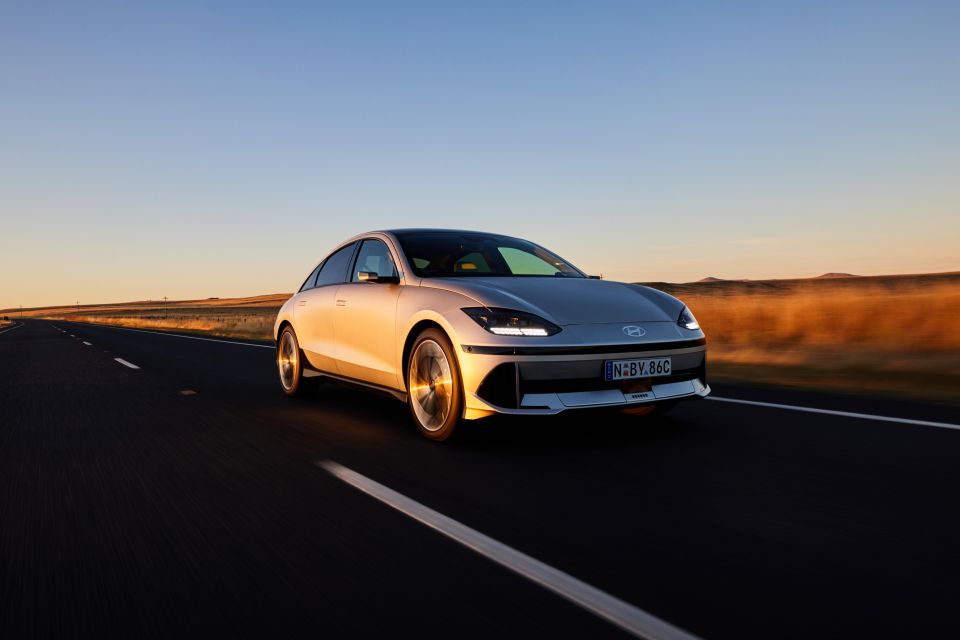
From its distinctive design to its fulsome feature suite, to its resolved and refined demeanour behind the wheel, the Hyundai Ioniq 6 is a very well-rounded and resolved offering that’s compelling on most fronts.
It addresses key criticisms of the Ioniq 5, and is cloaked in a really eye-catching body that turns heads and starts conversations. The noteworthy tech additions make its premium asking price that much more reasonable too.
Speaking of, while the entry-level Dynamiq RWD is $10,000 dearer than a base Tesla Model 3, its driving range, feature set, as well as its larger cabin are more than a match for the mid-spec Model 3 Long Range, which is actually dearer.

I also love the breadth of colour and trim options, even if the interior trim is tied to the exterior paint. Thankfully, Hyundai is working on a Built-To-Order program allowing more personalisation and potentially opening our market up for more variants and choice – watch this space.
My pick of the range? The base Dynamiq is all the Ioniq 6 you really need and is the only model to offer that headline driving range claim, though the allure of the Epiq’s techie Digital Side Mirrors makes for a nice ‘Burger with The Lot’ deal.
Also, if the base car is this good already, I’m very excited to see the realisation of the RN22e concept which should manifest into an Ioniq 6 N.
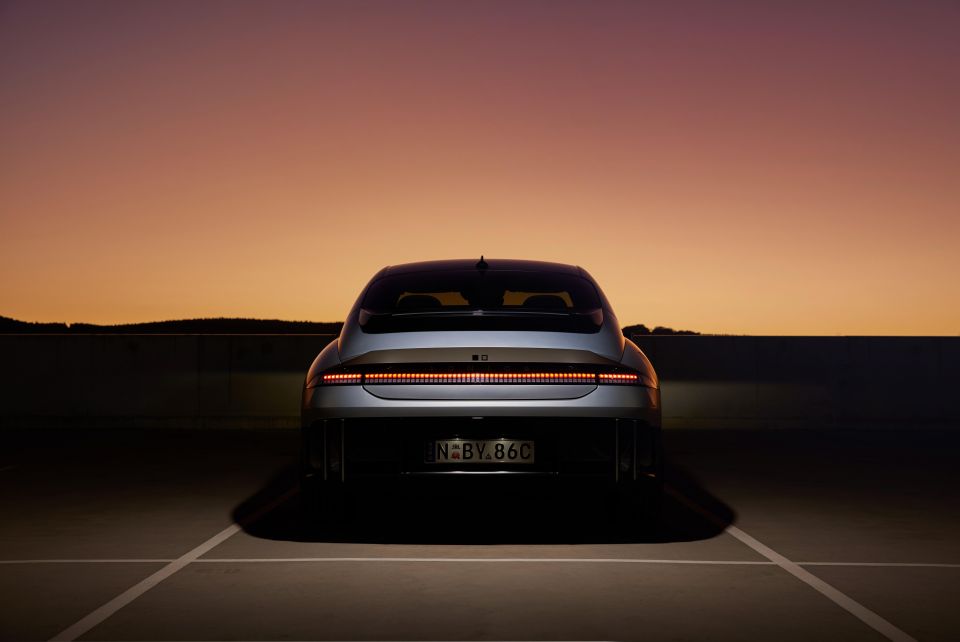
Click the images for the full gallery
Where expert car reviews meet expert car buying – CarExpert gives you trusted advice, personalised service and real savings on your next new car.
James Wong is an automotive journalist and former PR consultant, recognised among Australia’s most prolific motoring writers.


Andrew Maclean
39 Minutes Ago
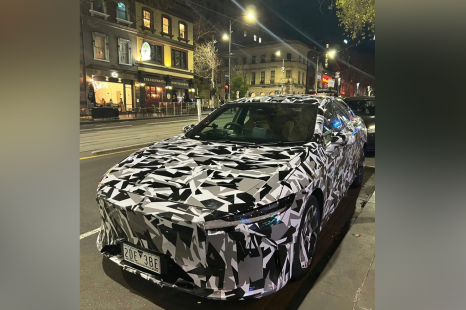

William Stopford
11 Days Ago
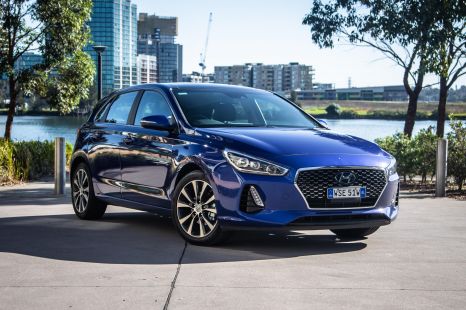

William Stopford
12 Days Ago
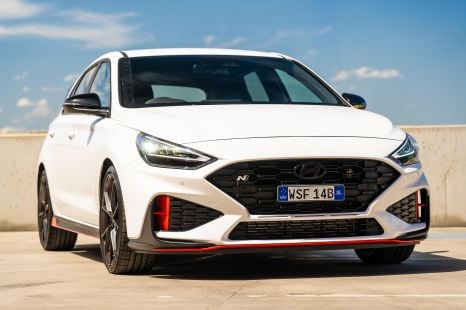

William Stopford
13 Days Ago
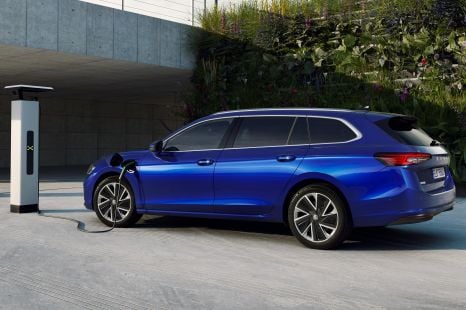

Josh Nevett
17 Days Ago
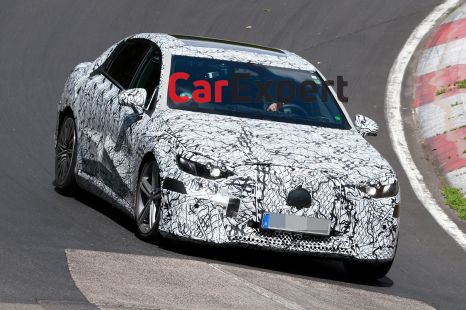

William Stopford
25 Days Ago